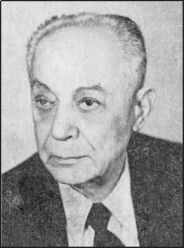- LOMIZE
- RUSSIA (see also List of Individuals)\
 13.7.1899 Tbilisi/RU - 30.5.1980 Moscow/RU\Grigory Mikhailovich Lomize was born in the Georgian SSR. He graduated in 1924 as a civil engineer from the Tbilisi Polytechnic Institute and there submitted in 1936 his PhD thesis, and in 1949 received the title Doctor of Technical Sciences. In the same year Lomize was appointed professor of hydraulics. From 1932 to 1951 he directed the Department of soil mechanics and seepage flow of the Transcaucasian Research Institute of Water Management, today's Georgian Research Institute of Hydraulic Engineering and Land Reclamation. Then, from 1951, he was the director of the Hydraulic Structures Department of the Moscow Power Institute, and from 1959 was a professor of soil mechanics and foundation engineering of the Kuibyshev Moscow Institute of Civil Engineering.\Lomize worked in the 1930s and 1940s mainly in questions of bridge hydraulics. In parallel he guided the scientific activities of the Transcaucasian research agencies. The investigations in seepage performed during the first five-year plans were directed towards the development of hydraulic engineering in Georgia. Practical applications of these research activities were hydropower installations of the Mingechaur, the Sevan, the Sion Dams, and the irrigation of Samgorsk and Kura-Araksa lowlands. Lomize prepared a number of books, among which mention might be made of the seepage and the drainage books. Lomize investigated practical questions of soil mechanics relating to strength and deformability of soils, and the mechanical soil properties. He also applied electro-osmosis in construction of civil engineering and proposed methods for sand compaction in drainage engineering. Lomize was in the Editorial Board of the Russian Journal Gidrotekhnicheskoe Stroitel'stvo and a Member of the USSR National Association of Soil Mechanics. He was awarded a Badge of Honor and Medals.\Anonymous (1969). 70th birthday of Grigory Mikhailovich Lomize. Hydrotechnical Construction 3(7): 673-674. PAnonymous (1980). Grigory Mikhailovich Lomize. Gidrotekhnicheskoe Stroitelstvo 50(8): 62. P Lomize, G.M. (1951). Seepage in fractured rock. Gosenergoizdat: Moscow (in Russian). Lomize, G.M., Nasberg, V.M. (1946). Drainage of underground hydraulic structures. Moscow. Lomize, G.M. (1973). Strength and deformability of soils. Hydrotechnical Construction 7(8): 725-737.Lomize, G.M., Sukhanov, E.I. (1974). Laws governing the flow of soils that have failed under loading. Hydrotechnical Construction 8(6): 519-526.
13.7.1899 Tbilisi/RU - 30.5.1980 Moscow/RU\Grigory Mikhailovich Lomize was born in the Georgian SSR. He graduated in 1924 as a civil engineer from the Tbilisi Polytechnic Institute and there submitted in 1936 his PhD thesis, and in 1949 received the title Doctor of Technical Sciences. In the same year Lomize was appointed professor of hydraulics. From 1932 to 1951 he directed the Department of soil mechanics and seepage flow of the Transcaucasian Research Institute of Water Management, today's Georgian Research Institute of Hydraulic Engineering and Land Reclamation. Then, from 1951, he was the director of the Hydraulic Structures Department of the Moscow Power Institute, and from 1959 was a professor of soil mechanics and foundation engineering of the Kuibyshev Moscow Institute of Civil Engineering.\Lomize worked in the 1930s and 1940s mainly in questions of bridge hydraulics. In parallel he guided the scientific activities of the Transcaucasian research agencies. The investigations in seepage performed during the first five-year plans were directed towards the development of hydraulic engineering in Georgia. Practical applications of these research activities were hydropower installations of the Mingechaur, the Sevan, the Sion Dams, and the irrigation of Samgorsk and Kura-Araksa lowlands. Lomize prepared a number of books, among which mention might be made of the seepage and the drainage books. Lomize investigated practical questions of soil mechanics relating to strength and deformability of soils, and the mechanical soil properties. He also applied electro-osmosis in construction of civil engineering and proposed methods for sand compaction in drainage engineering. Lomize was in the Editorial Board of the Russian Journal Gidrotekhnicheskoe Stroitel'stvo and a Member of the USSR National Association of Soil Mechanics. He was awarded a Badge of Honor and Medals.\Anonymous (1969). 70th birthday of Grigory Mikhailovich Lomize. Hydrotechnical Construction 3(7): 673-674. PAnonymous (1980). Grigory Mikhailovich Lomize. Gidrotekhnicheskoe Stroitelstvo 50(8): 62. P Lomize, G.M. (1951). Seepage in fractured rock. Gosenergoizdat: Moscow (in Russian). Lomize, G.M., Nasberg, V.M. (1946). Drainage of underground hydraulic structures. Moscow. Lomize, G.M. (1973). Strength and deformability of soils. Hydrotechnical Construction 7(8): 725-737.Lomize, G.M., Sukhanov, E.I. (1974). Laws governing the flow of soils that have failed under loading. Hydrotechnical Construction 8(6): 519-526.
Hydraulicians in Europe 1800-2000 . 2013.
